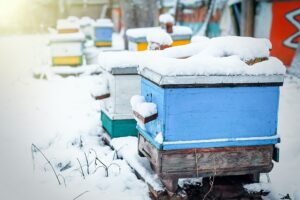
Welcome back to another adventure in beekeeping. You may have guessed by the title, but this week we are answering the age-old question: what happens to honey bees in the winter? You may recall that when we talked about pollination and the many paths taken by honey bee colonies, we wrapped up with the end of the pollinating season in/around November when most nectar and pollen sources have finished blooming, but what comes next? Well friends, that’s what we’re here to talk about today.
Did you know that unlike many other members of the animal kingdom, honey bees do not hibernate in the winter? And, unlike other varieties of insects, the colony does not die off or go dormant at the end of the fall season to start fresh in the spring (though they do come into spring with fresh bees, but we’ll get into that later). In fact, honey bees are very active in the colder winter months, but their survival depends on how well they (and their beekeepers) have prepared for the winter.
If you’re anything like us, you are constantly amazed at how much there is to learn about honey bees, and as we dug into this topic, we again found ourselves utterly fascinated by the inner workings of the hive. In addition to spending the summer and fall collecting nectar and pollen to store up for winter, there is actually an entire almost check-list that comes with preparing the hive for winter, starting with the queen herself.
Once the weather starts to cool and less flowers bloom, the queen will lay her last brood of the year, the winter bees. These bees are bred specifically for surviving the winter and have higher fat body content in order to keep the hive warm through the cold winter1. Winter bees also have an increased lifespan of approximately six months, compared to the average 28-35 days of the summer worker bee. After this brood, the queen will stop laying eggs until about January to maintain the hive’s resources (i.e. heat and food stores).
When the temperatures outside consistently fall below about 50°F, the bees prepare to close up shop, and they do so by cleaning house. Since the only role of drone (male bee) is to mate with queens, the worker bees will evict them from the hive for the winter. Once this is completed, it’s time to hunker down.
The winter bees will cluster around the queen and vibrate their flight muscles to heat the hive while feeding on the honey supply. Fun Fact: this thermoregulating cluster can maintain a toasty core temp between 77-100°F! As the temps outside fluctuate, the cluster will expand and contract to compensate, and on particularly warm days, the cluster will move about the hive and settle on a new honey supply2. These are also the days you may see bees leave the hive for a “cleansing flight” where they go out and relieve themselves, since they don’t defecate within the hive.
With the largest pollination event of the year taking place in the almond fields of California in February, the queen may begin preparing as early as January by laying again. The winter bees tend to this new brood to ensure a strong hive come spring when they are needed to pollinate more than 80% of the world’s almonds3.
The Role of Beekeepers
Now while all of this incredible activity is taking place in the hive, the honey bees couldn’t survive the winter completely on their own, and this is where the beekeepers come in. Similar to the bees, beekeepers spend the late summer and fall preparing their hives for the cold season. Here is a brief timeline/check list of how beekeepers prepare their girls for winter, according to Beekeeping Made Simple:
Late Summer:
- Harvest honey – leaving enough stores for the bees to feed on
- Treat hives for mites/parasites (if needed)
- Take steps to reduce honey robbing – this is when bees steal honey from other hives and can happen as nectar sources dwindle
- Place mouse guards on hive entrances
Fall:
- Ensure honey bees have everything they need to survive winter, including:
- Proper ventilation
- Something to absorb moisture
- Plenty of food (some may supplement with a sugar paddy or candy at the top of the hive in case of a particularly long season)
- A warm and sunny location – because who doesn’t love the sunshine?
- Insolation – this is typically done by wrapping hives in black tar paper or other materials that can help absorb some of the sun’s heat.
- Did you know that snow also acts as an insulator – think igloos!
- An upper entrance
Winter:
- Check the hive every 1-2 weeks
- Remove dead bees and snow from hive entrances
- Check food supply and refill as needed
As we all wait to spring to arrive, we will be just like the bees this winter – curled up in our homes staying all cozy and warm.
We want to hear from YOU! What surprised you most to learn? What other kinds of questions/topics would you like us to dig into? Tell us in the comments below.
SOURCES:
1 Gee, M. (2023, January 4). Winter bees: How honeybees survive the winter. Gees Bees Honey Co. https://www.geesbees.ca/post/winter-bees-how-honeybees-survive-the-winter
2 Center, L. E. N. a. S. (2019, December 16). How do honey bees survive winter? Lake Erie Nature & Science Center. https://www.lensc.org/how-do-honeybees-survive-winter/
3 CATCH THE BUZZ – Honey bees in winter. (2020, January 2). Bee Culture. https://www.beeculture.com/catch-the-buzz-honey-bees-in-winter/
